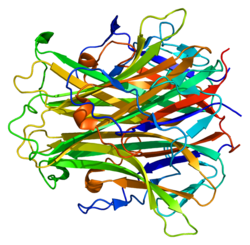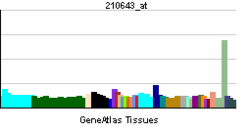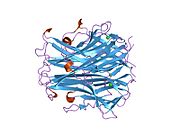RANKL
核因子κ-B配體受體致活劑(Receptor activator of nuclear factor kappa-B ligand,RANKL)又稱NF-κB受體激活蛋白配體[1],是一種在人體中由「TNFSF基因」轉譯出來的蛋白質[2][3]。
RANKL為腫瘤壞死因子超家族的一員,屬於第二型穿膜蛋白[4]。可以影響免疫系統和調控骨質新生和重塑。
RANKL在骨骼的新陳代謝方面,扮演著相當重要的角色。他是造骨細胞(osteoblast)膜上的一種膜蛋白(又被稱為CD254),可以活化蝕骨細胞(osteoclast),會加速蝕骨細胞破壞骨質並被吸收,為骨質更新的重要一環。當造骨細胞膜上的RANKL,活化了蝕骨細胞膜上的RANK蛋白,蝕骨作用就會開始。
RANKL的其他別名還有:「腫瘤壞死因子配體超家族成員11」(tumor necrosis factor ligand superfamily member 11,TNFSF11)、「腫瘤壞死因子相關誘導細胞因子」(TNF-related activation-induced cytokine,TRANCE)、「蝕骨細胞抑制因子配體」(osteoprotegerin ligand,OPGL)或蝕骨細胞分化因子(osteoclast differentiation factor,ODF)。
功能
[編輯]RANKL是腫瘤壞死因子(tumor necrosis factor,TNF)超家族的一員,為蝕骨細胞抑制因子(osteoprotegerin)的配體,屬於一種Ⅱ型跨膜蛋白。RANKL可以增強成熟蝕骨細胞的活力,阻止破骨細胞凋亡。[5]
免疫上,RANKL被視為是樹突細胞的存活因子。在「依賴T免疫反應」的途徑下(即反應必須經由輔助T細胞所致活),RANKL可阻止樹突細胞凋亡,促進T淋巴細胞增殖,且在淋巴細胞的早期發育和淋巴結的器官發育中發揮決定性的作用,這些作用可被OPG阻斷,而激活的T淋巴細胞表達的RANKL可直接促進蝕骨細胞生成,這些都提示OPG/RANK/RANKL系統可能是聯繫骨代謝與免疫系統之間的橋樑[6]。
曾經有文獻指出,T細胞的活化會刺激破骨細胞生成以及骨質流失。
此外,RANKL還可以透過與「SRC激酶」(SRC kinase),以及「腫瘤壞死因子受體相關因子6」(tumor necrosis factor receptor-associated factor 6,TRAF6)形成信息複合物,以致活AKT/PKB等細胞凋亡抑制激酶。這些跡象指出RANKL可能具有調節細胞凋亡的功能。[7]
實驗發現,將TNFSF基因剔除掉的老鼠,會導致嚴重的骨質石化症(Osteopetrosis),且會缺乏蝕骨細胞。此外,此種基因剔除鼠會在T淋巴球和B淋巴球的早期分化中,出現重大缺陷。且母鼠在懷孕期間的lobulo-alveolar mammary structures無法發育。[7]
臨床上的重要性
[編輯]骨骼
[編輯]如果人體製造了過多的RANKL,會造成各式各樣的退化性骨骼疾病,例如類風濕性關節炎(rheumatoid arthritis)和乾癬性關節炎(psoriatic arthritis)。 第一項被FDA認可的RANKL抑制劑是denosumab抗體;其也可用來治療女性更年期後的骨質疏鬆。
乳癌
[編輯]服用含有醋酸甲羥孕酮(medroxyprogesterone acetate,MPA)的藥物(一種合成黃體素,可應用於避孕以及替代激素療法)會增加得到乳癌的風險。MPA會促使乳腺上皮中的RANKL大量分泌,而誘發乳癌。因此RANKL抑制劑可望被用作預防乳癌的藥物。[8][9]
參見
[編輯]參考文獻
[編輯]- ^ 存档副本. [2023-12-04]. (原始內容存檔於2023-12-04).
- ^ Wong BR, Rho J, Arron J, Robinson E, Orlinick J, Chao M, Kalachikov S, Cayani E, Bartlett FS, Frankel WN, Lee SY, Choi Y. TRANCE is a novel ligand of the tumor necrosis factor receptor family that activates c-Jun N-terminal kinase in T cells. J. Biol. Chem. October 1997, 272 (40): 25190–4. PMID 9312132. doi:10.1074/jbc.272.40.25190.
- ^ Anderson DM, Maraskovsky E, Billingsley WL, Dougall WC, Tometsko ME, Roux ER, Teepe MC, DuBose RF, Cosman D, Galibert L. A homologue of the TNF receptor and its ligand enhance T-cell growth and dendritic-cell function. Nature. November 1997, 390 (6656): 175–9. PMID 9367155. doi:10.1038/36593.
- ^ Hanada R, Hanada T, Sigl V, Schramek D, Penninger JM. RANKL/RANK-beyond bones. J. Mol. Med. 2011, 89 (7): 647–56. PMID 21445556. doi:10.1007/s00109-011-0749-z.
- ^ OPG-RANK-RANKL系統在溶骨性骨腫瘤中的應用 (頁面存檔備份,存於網際網路檔案館),張強
- ^ Theill LE,Boyle WJ,Penninger JM.RANKL and RANK:T cells,bone loss,and mammalian evolution(J).Annu Rev Immunol,2002
- ^ 7.0 7.1 Entrez Gene: TNFSF11 tumor necrosis factor (ligand) superfamily, member 11.
- ^ Schramek D, Leibbrandt A, Sigl V, Kenner L, Pospisilik JA, Lee HJ, Hanada R, Joshi PA, Aliprantis A, Glimcher L, Pasparakis M, Khokha R, Ormandy CJ, Widschwendter M, Schett G, Penninger JM. Osteoclast differentiation factor RANKL controls development of progestin-driven mammary cancer. Nature. November 2010, 468 (7320): 98–102. PMID 20881962. doi:10.1038/nature09387.
- ^ Gonzalez-Suarez E, Jacob AP, Jones J, Miller R, Roudier-Meyer MP, Erwert R, Pinkas J, Branstetter D, Dougall WC. RANK ligand mediates progestin-induced mammary epithelial proliferation and carcinogenesis. Nature. November 2010, 468 (7320): 103–7. PMID 20881963. doi:10.1038/nature09495.
延伸閱讀
[編輯]- Whyte M. The long and the short of bone therapy. N Engl J Med. 2006, 354 (8): 860–3. PMID 16495400. doi:10.1056/NEJMe068003. link(頁面存檔備份,存於網際網路檔案館)
- Buckley KA, Fraser WD. Receptor activator for nuclear factor kappaB ligand and osteoprotegerin: regulators of bone physiology and immune responses/potential therapeutic agents and biochemical markers.. Ann. Clin. Biochem. 2003, 39 (Pt 6): 551–6. PMID 12564836. doi:10.1258/000456302760413324.
- Jeffcoate W. Vascular calcification and osteolysis in diabetic neuropathy-is RANK-L the missing link?. Diabetologia. 2005, 47 (9): 1488–92. PMID 15322748. doi:10.1007/s00125-004-1477-5.
- Collin-Osdoby P. Regulation of vascular calcification by osteoclast regulatory factors RANKL and osteoprotegerin.. Circ. Res. 2005, 95 (11): 1046–57. PMID 15564564. doi:10.1161/01.RES.0000149165.99974.12.
- Whyte MP, Mumm S. Heritable disorders of the RANKL/OPG/RANK signaling pathway.. Journal of musculoskeletal & neuronal interactions. 2005, 4 (3): 254–67. PMID 15615493.
- Clohisy DR, Mantyh PW. Bone cancer pain and the role of RANKL/OPG.. Journal of musculoskeletal & neuronal interactions. 2005, 4 (3): 293–300. PMID 15615497.
- Anandarajah AP, Schwarz EM. Anti-RANKL therapy for inflammatory bone disorders: Mechanisms and potential clinical applications.. J. Cell. Biochem. 2006, 97 (2): 226–32. PMID 16240334. doi:10.1002/jcb.20674.
- Baud'huin M, Duplomb L, Ruiz Velasco C, Fortun Y, Heymann D, Padrines M. Key roles of the OPG-RANK-RANKL system in bone oncology.. Expert Rev Anticancer Ther. 2007, 7 (2): 221–32. PMID 17288531. doi:10.1586/14737140.7.2.221.
- Yogo K, Ishida-Kitagawa N, Takeya T. Negative autoregulation of RANKL and c-Src signaling in osteoclasts.. J. Bone Miner. Metab. 2007, 25 (4): 205–10. PMID 17593489. doi:10.1007/s00774-007-0751-2.
- Boyce BF, Xing L. Biology of RANK, RANKL, and osteoprotegerin.. Arthritis Res. Ther. 2007,. 9 Suppl 1: S1. PMC 1924516
 . PMID 17634140. doi:10.1186/ar2165.
. PMID 17634140. doi:10.1186/ar2165. - McClung M. Role of RANKL inhibition in osteoporosis.. Arthritis Res. Ther. 2007,. 9 Suppl 1: S3. PMC 1924518
 . PMID 17634142. doi:10.1186/ar2167.
. PMID 17634142. doi:10.1186/ar2167.




